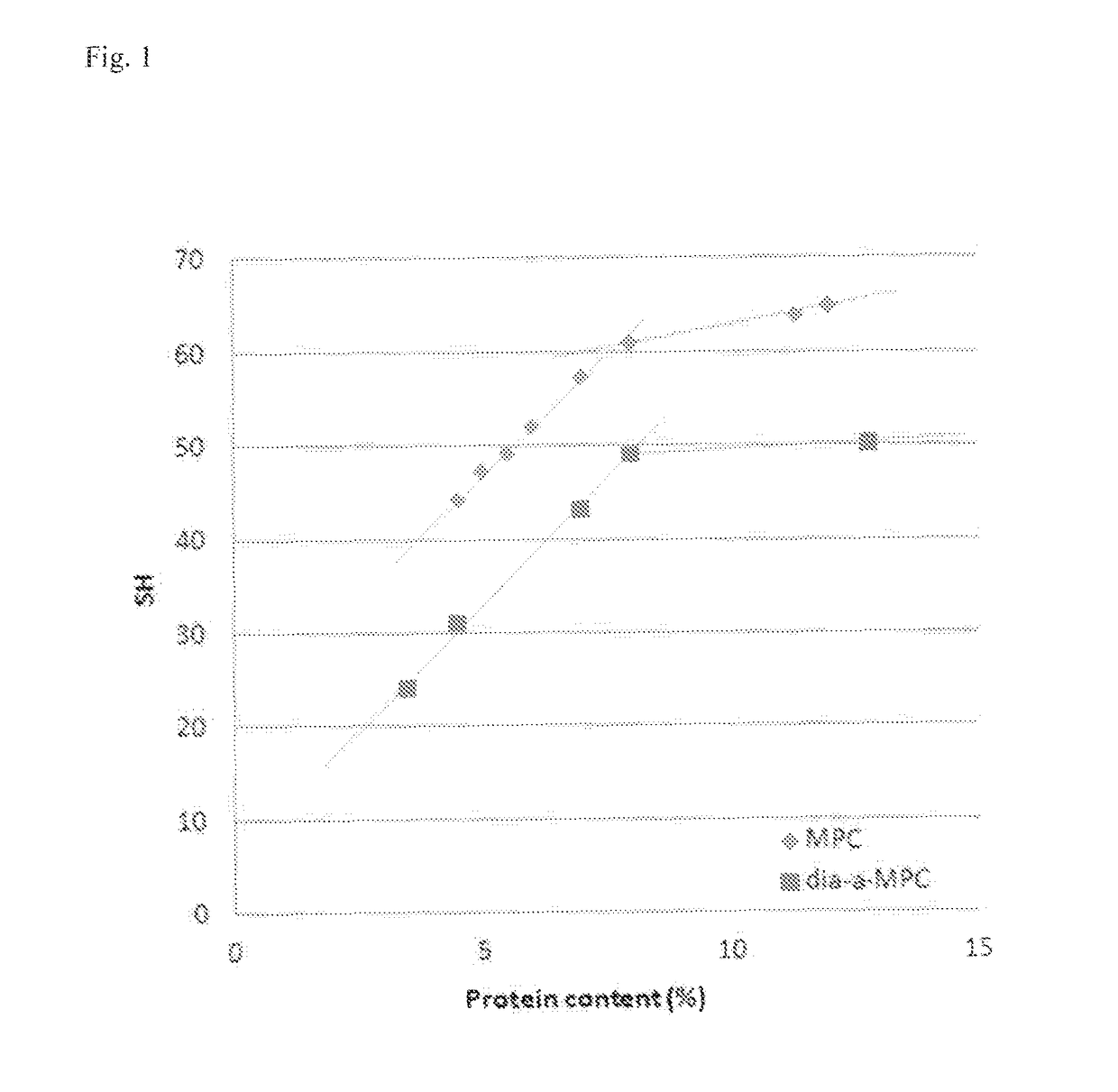Modification of mineral composition of milk for the production of an acidified milk product
a technology of mineral composition and acidification, which is applied in the field of modification of mineral composition of milk, can solve the problems of low economical unpalatable products, and low value of acid whey as a by-produ
- Summary
- Abstract
- Description
- Claims
- Application Information
AI Technical Summary
Benefits of technology
Problems solved by technology
Method used
Image
Examples
example 1
Milk Protein Concentrate
[0067]40 L of skim milk was high pasteurized at 80° C. for 7 min (dynamic pasteurisator), cooled to 10° C. and batch concentrated by ultrafiltration until concentration factor of 4.0 was reached. Spiral-wound element with Koch HFK131, 2540 having 10 kDa molecular weight cut-off (MWCO) was used. The pH of the ultrafiltration retentate was 6.8 and the titratable acidity SH was 10.9. Protein content of the retentate was 11.8%. The composition of the milk protein concentrate, i.e. the ultrafiltration retentate, is given in Table 1 below.
example 2
Acid Diafiltration of the Milk Protein Concentrate
[0068]The ultrafiltration retentate prepared in Example 1 was diafiltered with an acidic aqueous solution as a diafiltration liquid, containing lactic acid (1.5%) and monovalent milk minerals, i.e. sodium and potassium. The aqueous solution contained monovalent minerals in similar concentrations as the UF permeate obtained during the ultrafiltration concentration conducted in Example 1, i.e. only di- and multivalent ions were reduced. The pH of the feed was kept above 5.7 by adding water instead of the acidified nanofiltration permeate when needed. In total, 20 L of the diafiltration liquid was added to the ultrafiltration retentate in 1 L batches. The resultant diluted mixture was passed through the spiral element used in Example 1. No protein precipitation was observed. In concentration phase, half of the total lactose was collected in the ultrafiltration permeate. pH and SH of the diafiltration retentate were 5.9 and 21.2, respect...
reference example 3
Diafiltration of the Milk Protein Concentrate with Water
[0070]The ultrafiltration retentate prepared in Example 1 was diafiltered in the same manner as described in Example 2 except that water was used as the diafiltration liquid. The composition of the milk protein concentrate with a modified mineral composition obtained from the water diafiltration is given in Table 1 below.
TABLE 1Milk proteinconcentrateMilk proteinMilk protein(waterconcentrateconcentratediafiltration;Skim(UF retentate;(acid diafiltration;ReferencemilkExample 1)Example 2)Example 3)Protein (%)3.311.812.812.4Lactose (%)4.24.30.50.5Ash (%)0.71.40.91.0Na (mg / kg)330410110120K (mg / kg)14001760470510Ca (mg / kg)1100314025003100Mg (mg / kg)100210110150P (mg / kg)850223017401960Ca / P1.291.411.441.58
PUM
 Login to View More
Login to View More Abstract
Description
Claims
Application Information
 Login to View More
Login to View More - R&D
- Intellectual Property
- Life Sciences
- Materials
- Tech Scout
- Unparalleled Data Quality
- Higher Quality Content
- 60% Fewer Hallucinations
Browse by: Latest US Patents, China's latest patents, Technical Efficacy Thesaurus, Application Domain, Technology Topic, Popular Technical Reports.
© 2025 PatSnap. All rights reserved.Legal|Privacy policy|Modern Slavery Act Transparency Statement|Sitemap|About US| Contact US: help@patsnap.com

